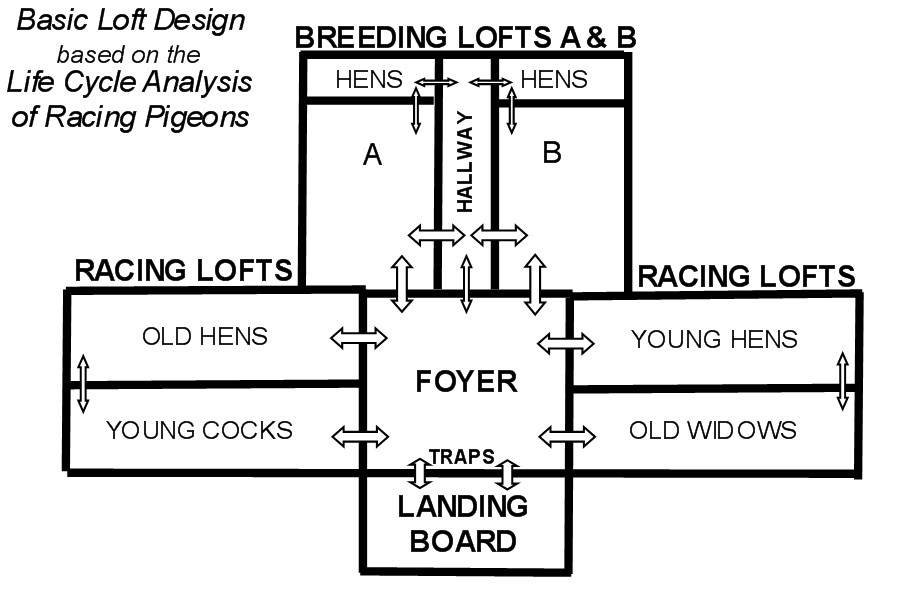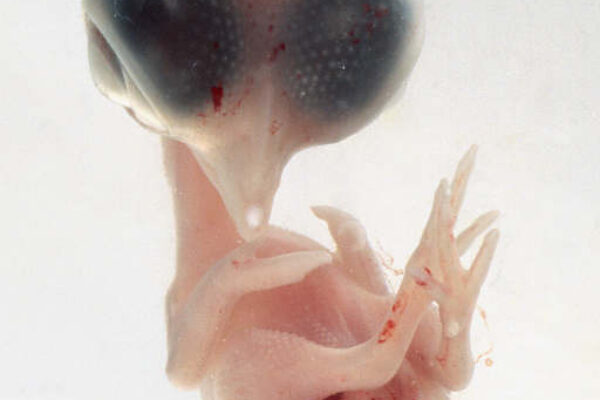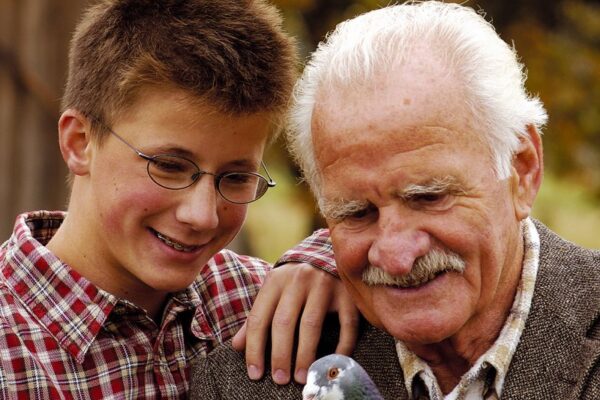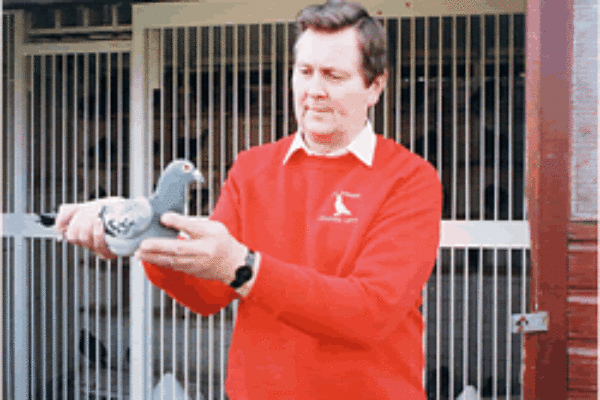Loft Construction and Design
In order for your race teams to perform well, the construction of your pigeon loft should reflect the type of race management system that you teach in Pigeon School. The following Basic Loft Design is based upon the widowhood system that I teach in my Pigeon School and represents the life cycle of my racing pigeons from hatching through retirement. Young birds are raised in the breeding loft from racers that are retired after they reach an AU championship or some other type of significant performance distinction or merit.
At weaning, the young birds are moved into the Young Cocks and Young Hens sections. The wire nest fronts in the widowhood nest boxes in these two lofts are folded to the back wall which divides the box in half in order to make two box perches out of one widowhood nest box. Twenty four widowhood nest boxes can become 48 box perches. When the final young bird team is selected on or about July 1st, the wire nest fronts are opened to make full widowhood nest boxes again. After the young bird season has concluded, the Young Hens are moved into the Old Hens section and the Young Cocks are moved into the Old Cocks section. These movements vacate the Young Cocks and Young Hens sections for the next young bird season. Old Cocks and Old Hens that achieve some type of champion or performance status are retired into the breeding loft.
A significant component of the loft is the trapping system. All of the pigeons trap into one common foyer or hallway for their entire lives. The breeding loft, the young bird loft and the old bird loft are not three separate buildings. These three lofts are integrated into one compact, efficient and extremely functional loft. Young Birds exercise and trap into their designated sections. Old Birds exercise and trap into their designated sections. Breeders exercise and trap into their designated sections of the loft. I find it cumbersome and inefficient to trap pigeons into three lofts spread all over the yard or garden; as well as retrain young birds to trap into an Old Bird loft and retrain Old Birds to trap into a Breeding loft.
The Basic Loft Design allows champion racing pigeons to live in the same loft for their entire lives. There can be modifications to this basic design that includes a feed and mud room, a section for extra pigeons, etc. Each loft is divided into sections. The right wing of the racing loft is divided into six 5 foot sections. So is the left wing. The Breeding Loft is divided into four sections not including the two Hens sections. This design is meant to represent a basic loft design. This design can be modified in many functional ways. For instance, since the landing board is about six feet high, the area under the Landing Board can become an aviary, a feed room, a small office area to wait for the race birds to return or a section for extra pigeons.
The nest boxes are all designed exactly alike. As I stated before, in the Young Bird sections of the loft – from February to July 1st – the nest boxes are divided in half to create twice as many box perches as former nest boxes.
A proper loft should be built for the comfort of fanciers as well as the comfort of pigeons. No more than twelve pigeons should inhabit a 5 X 6 ft. loft section. That is usually 6 racers plus 6 widowhood mates or twelve young birds before July 1st.
A fancier’s loft design and construction should reflect the race management system that he or she teaches in Pigeon School. A helter-skelter loft reflects a helter-skelter race management system. A loft that is scabbed together with little or no thought and planning generally reflects a very poor race management system and poor or sporadic race results. A well built well-organized loft usually reflects an organized well-planned race management system. There is a reason that most Belgian lofts are relatively nice looking and well organized. Most Belgian fanciers know how to properly teach and train their pigeons. While not all of them are wealthy enough to afford a picturesque loft built out of beautiful brick or stone; most of their lofts are very well-organized. Why? Because most Belgian fanciers know the basics of how to race pigeons motivated by a well executed race management system that is reflected in their loft design. It’s the only way to successfully compete in the Antwerp Union or the entire country.

Loft Construction and Design by Dr. John Lamberton
The Leading Online Pigeon Racing and Racing Pigeons Magazine – The Pigeon Insider









This Dr Lamberton’s loft diagram is a dream loft and is setup well. Old birds are fed in the widowhood nestboxes with soupspoons and the young birds are hand fed on the scraped foyer floor. He observes them to select the ones that are not afraid of him and exhibit qualities that place them above the rest for racing. I would like to see the ventilation for such a large complex loft. The cost of this loft must be substantial. Something smaller would do as well. Good to see this setup for it’s parts and method.
Dear Dr John
I am new to pigeons, my grand dad used to have them and since a child I have wanted to have my own, only recently I have been able to buy my first home with a garden where I can fulfill my dream. Please send me design or a blue print of a loft so i can build one. My aim is to start with 3 pairs only fancy pigeons not for racing but would want them to roam a bit in the garden and get back in their loft obviously they will grow so i would like to built a loft comfortable for up to 6 to 8 pairs.I live in London so please advice according to the weather conditions as it gets cold and rain through out the year with minimum of sunlight.Please also advice which way should the loft be facing. My email is [email protected]
Thankyou